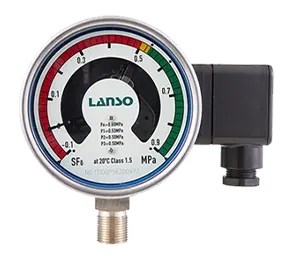As a common high-voltage appliance in the power system, the safe and reliable operation of the SF6 circuit breaker is crucial to the power supply system. In an SF6 circuit breaker, the SF6 gas density meter is a key component used to monitor and measure the density changes of SF6 gas, thereby ensuring the normal operation of the equipment. In this article, we will explore in-depth the structure and working principle of the SF6 gas density meter to deepen our understanding of its importance.
The structural principle of SF6 gas density meter
The SF6 density meter mainly consists of an elastic metal bellows, a gear mechanism, an indicator, and a double-layered metal strip. Essentially, a double-layered metal strip is added to the spring tube pressure gauge mechanism, thereby forming the basic structure of the SF6 density gauge. The elastic metal bellows is connected to the circuit breaker and communicates with the SF6 gas in the circuit breaker. The end of the elastic metal bellows is connected through a hinge to a double-layered metal strip, which provides temperature compensation, and the double-layered metal strip is connected to the gear mechanism and indicator through hinges.
The working principle of SF6 gas density meter
Impact of environmental temperature when not in use
When the SF6 density meter is not installed and used, if the environmental temperature is 20°C, the pointer points to 0MP. However, if the environmental temperature is not 20°C, the double-layered metal strip will compensate according to the difference in environmental temperature and 20°C. An increase in temperature leads to a decrease in the gauge's pointer, while a decrease in temperature results in an increase in the pointer.
The impact during the process of SF6 gas filling
As the pressure of the SF6 gas gradually increases, the end of the elastic metal bellows moves, driving the pointer to move in the direction of increasing density or pressure indication value. The indication value of the SF6 gas density meter is related not only to pressure but also to temperature. During the inflation process, because the SF6 gas suddenly expands and depressurizes, the temperature decreases, but the double-layered metal strip compensates at 20°C, it cannot compensate for the actual temperature difference from the environmental temperature.
The steady state of the SF6 gas density meter
After inflation, when the internal temperature of the SF6 circuit breaker is balanced with the external environmental temperature, adjust the SF6 gas to the rated density or pressure value. At this time, whether the pressure of the SF6 gas increases or decreases due to the influence of the environmental temperature, due to the temperature compensation effect of the double-layer metal strip, the density gauge pointer always points to the rated pressure or density value at 20°C.
Impact after the circuit breaker exits operation
If the circuit breaker exits operation, when the environmental temperature is balanced with the temperature inside and outside the circuit breaker, the indicated density or pressure value does not change with the change of external environmental temperature. When the environmental temperature rises, although the elastic metal tube moves, the pointer remains unchanged due to the offset effect of the double-layer metal strip.
Precautions: The SF6 density gauge can accurately measure the density or pressure value of SF6 gas only when the SF6 circuit breaker exits operation and the temperature inside and outside the circuit breaker is balanced. During operation, the reading error of the density gauge depends on the size of the temperature rise caused by the load current and circuit resistance of the circuit breaker.
By deeply understanding the structure and working principle of the SF6 gas density meter, we can better maintain and monitor the performance of the SF6 circuit breaker, ensuring the safe operation of the power system.
Related Article for Reference







